When
I receive the standard kit, what will it
look like?
| It looks
like a car without the
suspension and interior!
The standard kit is shipped with the body
(including
doors, trunk and hood) pre-fit and mounted to the chassis. All the
lights are installed, and the windshield is mounted. The foot-boxes,
floors and interior bulkheads are fit. The fuel tank with filler pipe
and cap are also installed. The suspension, wiring and interior are
packed in boxes. |
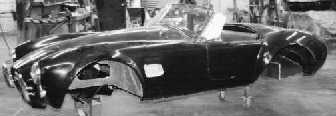 |
Can
I buy the kit in stages? The frame first, and then the body?
Sorry, no. We custom fit each body to the
chassis
to
insure that everything will line up correctly. Frankly, we are much
better at this than you could be, and we want to keep the final quality
high. Besides, too many people have an unrealistic view of how much the
project will cost and would end up with a permanent dust catcher/bad
investment in their garage. Not our style. We like
our kits
to be finished! We will, however, do just
about anything above our standard kit,
so you can get exactly what
you want.. Here's
an
example we've just put together, recorded by the customer.
We've
listed some sample kits here.
If you're want ERA to supply every single part, this (slightly old) list
(done for a customer) will
show how it's done.
| "All three
are
good cars. The quality of the finished
product
is
dependant
(sic)
on the builder." |
(A
quote
from someone |
With some kits,
that's the case.
But - because an E.R.A. is so complete,
and the
engineering so thorough, it's pretty hard to build an inferior car.
Use quality mechanical components, and the resale value of
your
finished kit will make you very happy.
I suppose you could do
a
poor paint job. 
DESIGN
What's
so special
about the E.R.A. 427? The
E.R.A. 427 was designed from the beginning to look exactly like the
original car, but without many of the original Shelby's shortcomings.
We have strengthened the chassis, improved the body mounting and
material, and thoroughly refined the suspension to make a better street
car.
Just
how close
to the original look is it?
We've
duplicated the outside shape, interior details and even the look of the
engine compartment. And check out this profile comparison.
You
don't
use a donor car? No. We felt
that
there would have been too many compromises to the basic
design,
performance and visual effect. While the potential to save
money
is there, there's also a whole bunch of dirty work involved in the
process of disassembly, cleaning, and replacing used parts.
Just
ask the people at FFCobra
Forum. Why
don't you use somebody else's front suspension?
There
were no off-the-shelf suspensions that
met all our design
criteria for both the front and rear suspension. Instead, we selected
components that could be integrated the way we wanted them to. We were
able to match the roll centers with the line of the front and rear
center of gravity. The alternatives we didn't like were:
- Mustang II, etc. Lousy geometry, small
brakes, solid
rear axle, but cheap.
- Jaguar (front): Lousy
geometry, small
brakes, expensive, but pretty.
What
about the Corvette
suspension? Corvette ('84-on)
suspension is lovely
stuff,
but
presents several problems:
- Pin
drive wheels cannot
be easily accommodated with the late model's integral wheel bearings.
Our ERA GT must replace the Corvette uprights and bearings
with
completely custom pieces. Can you say "expensive"?
- In
the
front, using the
Corvette control arms requires an extremely short steering gear.
We could use an aftermarket unit like Appleton or Sweet, but
these are not meant to go tens-of-thousands of miles, and their
straight cut gears allow too much feedback for the street.
- In the
back, the Corvette track is
much too wide. The half-shafts and lower control arms have to
be
changed. That's no big deal, but... the cast aluminum
differential cover, which also acts as the mounting bracket for the
entire assembly, would have to be extensively modified or replaced too.
There is also a strength issue with the differential.
Only
the LT-1 differential would be as strong as the Jag. It uses
the
same Dana 44 gear set.
- There is a problem
fitting the later
Corvette 12" brakes
into 15"
pin-drive wheels. They
don't.
On our GT, we use only 11.5" rotors on our custom hubs.
(This is not so bad on a car with only 40% of the weight on
the
front.). Since you can't easily modify the hubs to move the
caliper in, you're stuck with the earlier, smaller brake calipers that
were used only a couple of years.
- Thought you
could get
away using the stock shock
and spring?
Sorry! The leaf spring is too long. We
could either
make a new composite spring - an interesting proposition - or go to
coil-overs. This requires making a new shock bracket on the
hub
carrier. More complication.
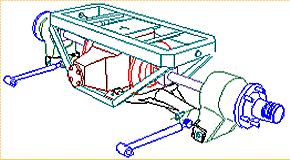 Why
is the rear suspension in a subframe? Why
is the rear suspension in a subframe? E.R.A.
is
unique in using a subframe on every
one of our roadsters.
The subframe does several thing.: It isolates the
differential noise and vibration from the chassis while still giving
positive location to the suspension arms. It makes servicing
easier. It also lets us use trailing arms to locate
the lower
control arms as originally designed. Without trailing arms, the lower
control arms are put into bending modes that they were never designed
for, allowing excessive toe change with power and braking forces.
Contemporary Classics' (now the defunct Burtis Motorcars)
replica
has an optional Watts link system that partially
compensates
for this - for about $1500! Our subframe also makes it easier
to service
the assembly. The rear suspension can be built as a unit outside the
car for convenience, and installed into the chassis in less than an
hour. Even our optional "track" suspension is in a subframe.
Is
the Jag differential
strong enough? You bet!
The Jaguar piece
is a
Salisbury made unit
that uses Dana 44 gears. It was used (with a slightly different
casting) in the original
427.
The few problems some people have encountered resulted from drag strip
events while using high-traction slicks. And that particular weakness
can be cured with available high-strength stub axle shafts available
from Concours West. Remember! You can only exert so
much
traction in a car that weighs 2600 lbs., even with over 50% of the
weight on the rear axle. We've looked at the much vaunted
Ford
9". I doesn't offer any advantages - and it costs more.
What
about the rest of the pieces?
I've heard that the Jag axles break. See
here for how we modify the Jaguar pieces.
You
use
the half-shaft as the upper control arm?
Yes.
Because the axle is much
stronger than any control arm could
be, and we modify it (see above link) to be fail-safe, there's
no
reason not to use it as a working member. The axle has proved
to
be absolutely reliable in more than 800 cars.
That dual-use
saves weight, space and complication. Can't
I
use a solid rear axle?
Because of
the engine placement, the drive-shaft would end up too short for
adequate wheel travel. Some other solid-axle kits limit the
total travel to
under 2". While this might be OK for a race car, it
is
grossly inadequate for real streets (at least east of the
Mississippi...). We have 6.5" of travel at both the front and
rear. If you drive on less-than-perfect roads you will
appreciate
the "luxury" of an IRS. A good independent suspension (like
ours,
of course) will give you excellent handling with a reasonable ride.
Remember, the original car had it - for a good reason! (If
you
want to see some real-life results of the solid axle, do a search on Cobraforum for
"driveshaft".) How
about the Ford 9" differential?
There are several reasons
that the 9" isn't the
best choice. The unit is not interchangeable with the
Salisbury
in our subframe and would require aftermarket calipers and a very Rube
Goldberg emergency brake. Also, the pinion offset is about
1.5"
lower than the Salisbury, making the driveshaft angle down excessively.
Since the nine-inch wasn't designed for an IRS halfshaft, the
conversions are quite expensive too. 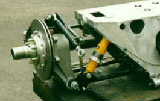 Why do
you have an optional
rear suspension? Why do
you have an optional
rear suspension? Many of our
customers spend most
of their driving time
on the track. While the Jag brakes are perfectly adequate for
hard street use, they don't cool well under track conditions.
We
took the time to re-design the whole assembly to move the brakes
outboard and make them bigger. We also changed the geometry a
bit. Extensive use of aluminum and a more efficient design
makes
the unit about 50 lbs lighter too. Can
I get a
roller? Sure! We don't have
a
standard package because of all the possibilities, but we can put
together exactly what you are looking for. The roller will
have all the parts installed and functional:
Typical cost
is approximately $6000 plus your wheel choice, but the individual
prices are listed here.
- Front
suspension, with adjustable coil-over dampers
Optional anti-sway
bar - Front brakes, complete and
functional -
Standard
GM calipers on 11" vented rotors or
optional 4-piston calipers on 12.2" vented rotors - New
steering gear
- ERA custom steering column and
reproduction
wheel by Moto Lita
- Rear suspension - either
Jag-based or
our own ERA-design
Optional anti-sway bar -
Brake reservoir
What
about all-wheel-drive?
That's just too many mechanical
parts to fit into a
small car with a big engine!
How
do you make the
fiberglass body? The main
body, doors, trunk lid, hood and the inner panels are all
hand-laid right here at our production facility. We use a
high-temperature low-shrink resin and the best quality fiberglass mat.
We don't use cloth because it will eventually print throug
the
gel coat and ruin the exterior paint's finish.
After the
main shell is laid, it is rough trimmed. Then it goes to the
assembly shop where it is put in a jig where the inner panels are bonded and
holes for the
lights are cut. Then, each body is hand-fit to
its chassis
so that you know that the doors, hood and trunk will function perfectly
when you pick
up your kit. Do
you offer
an aluminum body? Sorry, no.
While we
use aluminum panels
for most of the inner panels, we don't have an aluminum body skin.
For that, go to Kirkham
Motorsports or Shelby
American. It is not
practical to retrofit an
aluminum skin to our chassis. Why do
you bond the body to the chassis? The
results
are a stiffer overall structure,
with no rattles, creaks or
shakes. Our fiberglass bodies simply do not get stress cracks, even
after many hard miles on the road. The process is a bit more work, but
well worth it! Some claim that their body is
"unstressed"
because it is rubber mounted to the chassis . Wrong!
The outside shell must
still be supported with inner panels or some other structure.
The
effectiveness, thoroughness and method
of that connection is what
determines whether stress cracks appear.
Doesn't
bonding the body to the chassis make
it more difficult to work on?
Not
really. Our car, with its removable tunnel, is designed to
be very easy to service. In fact, every
turn-key we do
at the factory has the body bonded and painted before any of the
mechanical bits are installed.
What
about stone chips from stones thrown up by the tires?
All our bodies have thickness added to the
fiberglass (with Coremat©
and an extra layer of glass) over the tires. Many people also
add vinyl protection or spray-on Chip Guard© on the front of the rear
fenders to fend off stones thown from the front tires.
Does
your kit use a
"tubbed" interior? No!
Except for the fiberglass footboxes (as used on the original
car), the interior is built up of separate aluminum panels riveted and
bonded to the chassis and to special flanges bonded to the door
openings. In addition, the wheelhouse
panels are all
CNC-cut alumninum, protected on the visible side with plastic sheet so
that they stay scratch-free during construction. We use
0.050"
thick Marine-grade (5052H32) aluminum throughout for the best
resistance to staining and corrosion. You can see what
happens with a non-marine grade (6061) here.
| 
In
addition, the aluminum tunnel is removable for
transmission and clutch service. |
Why
do you use separate
aluminum floor and bulkhead panels? We
have
tried to duplicate the original concept
as much as possible, and
avoid the "dune buggy syndrome" of a single interior shell. This is a
bit more work to put together, but it saves weight and allows much more
design flexibility. Our tunnel (fiberglass on the 427, aluminum on the
FIA) is removable for service, and we have an access panel behind the
seats for rear (inboard only) brake service. Separate
footboxes
also allow us to create a stronger structure to support the cowl and
door mounting hinges. | Is
the roll bar functional?
While our
(visual-duplicate-of-original) single-width
roll bar, full-width
bar and a dual roll bar configuration (at right).
doesn't meet current racing specifications, it is
fully
structural, bolting directly to the main frame rails.
We
also offer a | 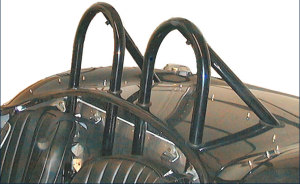
| How
much
does your car weigh?
The 427 weighs about 2600
lbs
with an iron FE engine. This is about 100 lbs more than an
original car, put mostly into the stronger
chassis.
Some other kits claim much lower weights. What they don't tell you is
that they are not using a big block where appropriate, the strength of
their car is much lower, and they are missing a lot of pieces necessary
for an authentic street car. When you feel how solid
our
car is, you won't regret the slight extra weight! Additionally, many
new aluminum engine parts are available, potentially taking
another 200 lbs from the car.
What
about the Superformance? Superformance
kits are only sold through dealers as a "turnkey minus".
That is, it includes everything (including paint) except for
the
engine and
transmission. It's quality is quite good, and they include
many
standard pieces. Most people have their dealer complete their
car, and for many, it's the best choice.
But for those who require
the ultimate in design and quality, there's ERA.  We use
much more aluminum for inner panels, have more original-design
components, and many claim our body shape is better. We've
posted
some more details here.
We use
much more aluminum for inner panels, have more original-design
components, and many claim our body shape is better. We've
posted
some more details here.
Hey!
What about the new Shelby 4000 series Cobra?
As far as being a "good car", it seems to us
that the 4000
series tends to combine some of the worst characteristics of the
original car and a kit. It retains the original chassis
(except
with heavier wall thickness), but puts a mediocre fiberglass or
expensive aluminum body on top. While the wheel housings are
aluminum, the interior panels on the fiberglass-bodied car
are
'glass too. Feedback from kit constructors indicates that it
takes much more work to complete, too. For instance, the
"carpet"
simply consists of a roll of material. Not cut, not bound.
While the body is mounted on the chassis, all the inner
panels
seem to be just floating there. A great deal of final
assembly is
expected of you. Our car feels, looks and
handles better.
The 4000 series does have Shelby's name on it, though.
Hopefully that's worth the extra $20 thou' that you'll spend
Or if you want to go further, you can get an aluminum body
with
the 4000. About another 20 grand...
Do
you
offer Right Hand Drive? We
don't
have off-the shelf pieces to make an economical switch. It's
fairly easy to switch the steering and brakes, but the foot boxes will
have to be custom made. Figure in the thousand$.
DRIVE-TRAIN
What
engine do you recommend?
| Ford
Engines Defined: A
Small block Ford is within the 260/289/302/351
series. The
Big Block can be either an FE (360/390/427/428, vintage 61-68) or a 385
Series (429/460) after '69. Each series is a completely
different
design. |
| Most people
don't
know that there was quite a mix of
engines
(All FE
series) put into the original cars. Side-oiler 427s were
mixed
with center-oilers and stock 428 Super Cobra Jets.
The
side-oiler was a short stroke version of the FE, with an improved
oiling system for high RPM NASCAR racing. It only had a
single
4bbl carburetor. The later cars used 428 engines with 2x4bbl
carburetors. All the FE series look the same from the top, except for
the carburetion. | 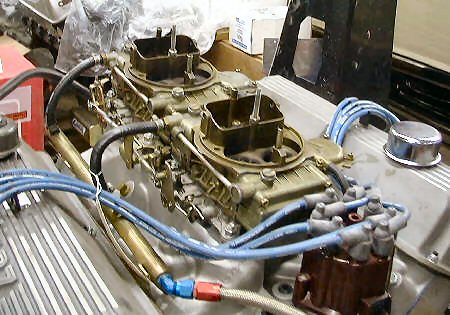
Dual-quad Holley carbs
were used on
the 428 engines and frequently retrofitted to the 427 Side-oiler.
Two good reference books
are Big Block Ford
Engines by Steve Christ, and Ford
Performance by
Pat Ganahl. They are both available from the Amazon.com
and Barnes
and Noble on-line book stores.
Just search on the
authors' names. |
Horsepower
was originally somewhat higher with the 427, but at the expense of
diminished low speed torque. Because of the scarcity of very high
octane gasoline (the 427 had 12.5:1 compression ratio), a current 427
rebuild is usually not much stronger at top RPM end than a well built
428. A SOHC
(Single OverHead
Cam) variation of the 427 was built by Ford, primarily as a drag
engine. Huge ports allowed this engine to have more
horsepower
than any contemporary (circa 1967) engine, but at some costs.
The new cylinder heads make this engine very wide, and not a
very
practical installation into a small roadster - but of course, it
has been done.
The 427 Center Oiler is
another alternative. This block retains the same bore and stroke of the
side-oiler but retains the lubrication system of the 428. Found in a
lot of boats, this engine as a core can be bought for much less than
the side-oiler. The 390 is
the most economical FE
engine.
With the right parts, it can put out nearly the horse-power of a good
428. We also have mounts for the 429/460 engine, but because of the
increased engine width, we must cut into the footboxes, stealing some
foot room. We have designed the car around the
Ford FE
engine, i.e. 390/427/428, but you can use other engines. Just remember,
though. E.R.A. 427's are famous for having the right mechanical parts.
If the time should come where you want to sell your car, an odd engine
will probably make your car worth less. It's designed around that
engine. Customers have fit the FE engines with
some
interesting intake systems. In order to keep under the hood
(scoop), it's best to stay with low or medium-riser heads and stay away
from tall intake manifold. On the other hand, DCOE Webers
will
work if fitted with short intake stacks. At least one ERA
owner
has converted to mass-flow
fuel injection. If you have your heart
set on using a
small block Ford, we recommend that you think about getting the 289FIA
version that we offer. What
about the 429/460? Ford Motorsport is
offering very
economical
429s, but their width
requires custom-made foot boxes, wiring harness and primary exhaust
pipes to fit the standard side pipes. We do
not
support the hemi version of the 429. What
about the Ford Mustang 4.6L "Modular" (32
valve) engine? We
have installed
one of
these engines into an FIA (very
similar) chassis. It was a difficult and expensive project, requiring
new reduced-width footboxes, steering column and pedals. The
oil-to-water intercooler must be removed from the block and a custom
block-off plate made. New fuel feed and return lines must be made, and
a very expensive wiring harness is required. Even
more work than installing a SOHC! See
just how
large the
4.6L engine is!
What
about a Chevy? Noooooo!
 Seriously, we do have mounts for the Chevy, but we
strongly discourage it. We have only done a few (out of more
than
700 cars), and a couple of those have been converted back! We
have done no detail development work with the "mouse" or "rat"
engines except for the mounting system. You will have to
adapt
the wiring harness, and make custom headers and clutch release system.
The Chevy engines, in addition, are significantly heavier
than
their Ford counterparts. In our experience, when you sell the
car, it will be valued almost as if it had no engine at all.
Seriously, we do have mounts for the Chevy, but we
strongly discourage it. We have only done a few (out of more
than
700 cars), and a couple of those have been converted back! We
have done no detail development work with the "mouse" or "rat"
engines except for the mounting system. You will have to
adapt
the wiring harness, and make custom headers and clutch release system.
The Chevy engines, in addition, are significantly heavier
than
their Ford counterparts. In our experience, when you sell the
car, it will be valued almost as if it had no engine at all.
How
do I find an engine builder?
Ask around your
local Shelby or Ford club for
someone local, or select from our own list
of preferred
(local to ERA) builders.
| What's
the best transmission
to
use? With all Ford engines,
you can use
the original Top-loader 4 speed (built by Dan Williams
or David
Kee) or the
Richmond Gear 5 speed. The 4 speed is normally combined with a 3.54:1
or 3.31:1 differential ratio. The 5 speed has a direct drive 5th and
works best with a 2.88:1 or 3.07:1 ratio for a better top gear cruising
RPM. A Tremec 500 or
600 5
speed can be used with all engines, using a 3.31 or 3.54:1
differential. A Tremec
TKO or TKO II 5 speed can be used with
mild big blocks,
using a 3.31 or 3.54:1 differential. We do not
support the
Richmond Gear 6 speed or late-model Ford T56
(modular-engined)
transmission. |
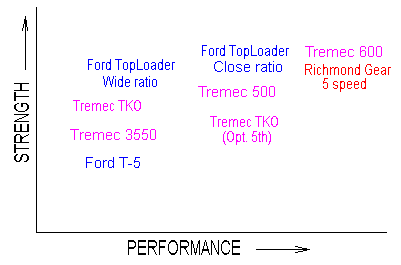 |
If you are using a Ford
small block, both the above transmissions can be fit, plus the Tremec
and
certain variations on the T-5 as described here.
The
"best" transmission for you
depends on
what you're going to do with the car. For everyday driving,
the
Top-loader wide-ratio or Tremec may be the best choice for you.
Both offer a good starting gear, and the Tremec has an
overdrive
5th gear for comfortable highway cruising. The close-ratio
Top-loader and Richmond Gear 5 speed are more performance-oriented,
with gear spacing that keeps the engine's rpm's within a narrower
range. Specific gear ratio combinations are listed here.
While
we haven't done many kits with them, you may
also specify
chassis mounts for a C-4
or C-6 automatic.
We will eliminate the clutch pedal and move
the brake
pedal to the left on request. The radiator has no integral
cooler, so you'll have to add an external one.
What
about the shift handle and linkage? The shift
handle was angled
forward in the original Shelby 427. It looked odd, but it
actually works very well. For those who don't want to make the pieces
themselves, E.R.A. offers a reproduction
handle and linkage for both the Top-Loader and
the Richmond
Gear 5 speed, and handles that bolt onto the Tremec and T-5.
What
kind of clutch should I use? Because
the car is
very light, a
standard-pressure
clutch is fine. Any slip will come (accidentally, of course) from the
tires. What
are
pin-drive wheels? <Pictures
here!> 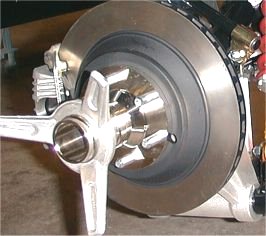 The
original Shelby Cobra wheels used a
single wing nut that secured each cast magnesium wheel. The power was
transferred from
the hub to the wheel by six pins. The 289/FIAs used a casting unique to
the race cars. Vintage Wheels, and Trigo Wheels are now duplicating the original design in
aluminum, with offsets that fit the E.R.A. cars. The
original Shelby Cobra wheels used a
single wing nut that secured each cast magnesium wheel. The power was
transferred from
the hub to the wheel by six pins. The 289/FIAs used a casting unique to
the race cars. Vintage Wheels, and Trigo Wheels are now duplicating the original design in
aluminum, with offsets that fit the E.R.A. cars.
The
original 427
street cars used a Sunburst
pattern and were 7" wide front and back. They are not replicated by any
manufacturer, but some are available used. The competition
cars
used an early GT40 design, 7 1/2" wide front, 9 1/2" rear. Our 427
pin-drive wheels duplicate the GT40 design, but cast in aluminum. For
day-to-day use on the street, magnesium corrodes
quickly and
requires a great deal of maintenance. If you
want 17"
pin-drive wheels, they are available from PS Engineering.
Also
available are new 5 pin wheels. Externally, they are
identical to
the GT40 design, but they are mounted on adapters and driven by 5 pins
that double as lug nuts. They are about $1000 cheaper than
the
original 6 pin system that we sell. What
are the other wheel alternatives? For
the 427,
there are
many bolt-on wheels
that have the "Halibrand" look at reasonable prices. Check
out Vintage Wheels and others.
Offset specifications are available here for various
width and
diameter wheels.
| What
size tires do
you recommend? For the 427, we like to use
235/60-15
in
the front, 295/50-15 in the
rear. These sizes duplicate the original cars' outside
diameters. This
makes the car look "right".
Avon (U.K.) now has 15" V rated tires in 225/65
and 295/50
sizes. They are imported
into the
US by Sasco Sport. In the USA, some of the best performance
tires are only
available in 17" wheel diameters. Our 427 will accept
275-40-17
in the front, 335-35 -17in the rear. That's a lot of rubber!
Tire
diameter calculator
|  |
 How
about
a spare tire? How
about
a spare tire? With
a bolt-on
wheels, you can use
a GM-pattern wheel with a
standard (small) tire. With pin-drive wheels, we
offer a
special narrow wheel that mounts the smaller tire. Remember,
though - use of different diameters of tires on a limited-slip
rear-end is only very temporary! Most
people, in order to maintain the full
trunk space, will simply carry a couple of cans of Fix-a-Flat
and a
cell phone.
What
kind of brakes do you use? In the front
we use 11" diameter x 1" wide vented rotors with floating calipers.
These were originally mounted on the front of much heavier cars and are
more than adequate for street use. 12.1" and 12.8" rotors
with Forged 4-piston Wilwood calipers are optional.
In the
rear 10.5"
diameter x 1/2" thick rotors are mounted inboard to reduce unsprung
weight. 10.5" vented rotors are optional. If you
get our optional
rear suspension,
the standard brakes are 11.75" OD x .81"T vented (outboard) rotors.
Our pedals are mounted directly on the chassis, below
floor level, like
the original, with aluminum pivoting faces. Like
the
original, we don't use a booster in the system. The pedal pressure is
moderate but very positive.
What
about
the exhaust system? | The
"Classic" 427SC had competition pipes
under the doors. Being real race cars, the finish was not
particularly important, and they were typically painted with a simple
high temperature paint - usually white (see the top picture), sometimes
black. No gloss, and the paint didn't stand up very well.
On the other hand, a simple spray can would rejuvenate the
pipes.
Some people, wanting a more durable finish, have there pipes ceramic
coated. Central
CT
Coatings does ours. Several colors are available,
but the
silver stands up best. However - because the standard steel
pipes
use a fiberglass packed internal muffler, the pipes will have to be
replaced eventually - if you can't tolerate them getting very
loud. You can also chrome the pipes.
The best
long-term
solutions (and the most expensive) are stainless steel pipes.
They are internally baffled so should last a lifetime.
They
will turn slightly yellow from the heat, but that's removeable with
polish. |  |
Street-Style
Cars Some prefer
the clean look: Under-car exhaust, no roll bar or hood scoop, with the
street dash layout. The exhaust system
shown at the
right
has an unusual exit, right in front of the rear wheel. If you
get
our optional outboard-braked
rear suspension, this configuration is manditory.
Otherwise
the pipes can exit at the back. | 
|
| The picture at the right (289)
shows where the pipes normally exit. The exhaust duplicates the look of
the original street car and is quiet under cruising conditions.
Ground clearance is about 4" under the tri-flow mufflers.
You'll lose a
bit of
horsepower, though. |  |
Is
my car going to overheat?
Our
standard 2 x 1.25" aluminum
core radiator
is oversized for practically any engine, including 500 cubic inch
monsters. In traffic our standard
electric fan
will cool most mild big block engines (depending on your climate), and
we offer several fan options to cool just about anything else.
| You
put the
battery up front? Our standard car
mounts the battery on top of the passenger's
footbox, in approximately the same place as an
original street
car. Optionally, you can move the battery back into the trunk
for more
rear weight bias.. The battery can be removed and
replaced
by removing the engine valve cover.
|  |
PERFORMANCE How
does the car go? Depending on the
engine, 0-60 MPH
times will
be from
4 to 6 seconds.
How
does it stop? Very well, thanks.
Stopping distance from 60 MPH is about 135 ft. The brake balance is
adjustable for personal tuning. A car with stock brakes did
0-100mph-0 in 12.07 seconds. You do the math!
How
does
the
car ride? Surprisingly well.
Spring rates, while not exactly boulevard cruisers, are quite
reasonable for such a high performance car. The fact that chassis flex
is so low enhances the feeling of total control. Everyone
comes
back from their first ride saying "This
is
a really nice car!"
| The
new owner commenting on kit #490 (built 10
years ago):
"I
wish my
Acura was this
solid." |
And
another comment on Club Cobra
The
suspension is so supple that the ride is
comfortable even with 17" wheels.
How
does the 427 compare to a modern
sports car? You're
more in direct
communication with the road. Without power
steering, you feel much more - and it takes more effort to do things.
"Bite-wise", the car will stack up quite well to
its
equivalent new car. Fitted with new rubber, the 427 will do
over
.95G with street suspension. And it doesn't bounce from bump to bump -
there's plenty of suspension travel. This is a car bred for
Connecticut, where potholes are the ubiquitous companions.to our
favorite back roads. How about
fuel economy and reliability? You
have to ask???
Seriously, the more "stock" the
engine is, the better the mpg. You could get 14-18 mpg out of a low
horsepower 390, but with 550 bhp, you'll probably get 8 mpg.
If
you want the best reliability, stick with a stock engine.
Unless
you throw a lot of money at an engine, higher horsepower will always
result in higher maintenance.
Comfort
| How
about this for a quote? | "Bob,
thanks for the info on car
191. The current owner has done some improvements to the engine and
ignition. He loves the ride and says his friend who owns big block
Corvettes says your ERA rides 10 times better! He even said it rides as
well as his 85 5.0 Mustang!" |
| Because
we've spent many years
"standardizing" springs and dampers, you can be assured that you can
have the same high level of comfort. |
Do
you have any
interior ventilation? We
have footbox
vents on both the
drivers and passenger's side, controlled by separate dash knobs. Few
other kits even offer ventilation. In addition, we offer
optional wheel-well
vents
so that the heat from the headers will be vented outside the engine
compartment.
Can
I
drive it in the winter?
One
person's experience:
| "Bob,
I saw
your response to the
fellow who wants to know how to drive in the winter and with what
equipment. As you know I am going into my 3d winter of driving my 289.
The top is on and the sidecurtains go in if it is particularly cold or
inclement. I rarely use the heater/defroster, because the cockpit with
the heat vent on is plenty warm. I have driven in snow, rain, and the
dark of night. The ERA keeps on trucking. Tell the fellow to JUST DO
IT!" |
What's
the difference between your
standard vinyl seat and the optional leather ones?
Not a lot! | 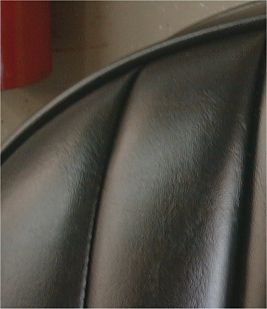
Vinyl,
up close. The texture is
actually a bit more "leather-like" than the leather shown at the right.
Few people can tell the difference. Real leather's
texture
will vary from hide to hide, so the grain varies slightly from fine to
slightly coarse. | 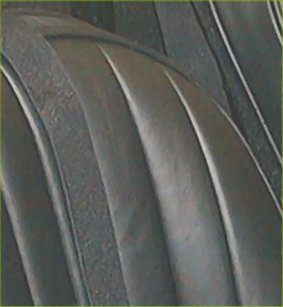
The leather
has
a slightly softer feel and
the characteristic smell. On the other hand, it will require
quite a bit more maintenance. We buy the leather in whole
hides,
so that both seats come from the same hide and the texture will
be consistant on both your seats. |
I'm
LARGE.
Will I fit in your car? Our
cars have
more room than any other standard wheelbase replica and will easily
accommodate people up to 6'3". We have increased
the length of the foot-boxes
about 2" over the original
car and also have pedals that are adjustable. For the most
long-legged, we can substitute a larger clutch master cylinder to gain
an additional 1.5" at the expense of more pedal pressure. If
you
are very large, we recommend coming in for a butt-in-seat
test. For those with extra long upper torsos, we can
adjust the amount of
padding in the seat bottom to get you a bit closer to the floor.
The
steering column is also adjustable up and
down with spacers. Compare
these dimensions with
your kit of choice!
| 
Seating
dimensions with standard layout |
| "I
am 6'4" -- my ERA fits me like a glove. I did fly up there and have a
butt in seat measurement test though, along with the pedals moved back
which means a larger clutch master cylinder, less padding in the seat,
lowered and moved back as well. And yes, I look square out the middle
of the windshield, not like a "clown car" where you peer over the top. Here is a shot of my head driving
away...". Here is a shot of my head driving
away...".
Pat
T #732 (6'4"
tall)
|
| Do
you have a top? Of course!
The optional
top
is a duplicate of
the original, fastening to the windshield and the lift-a-dot fasteners
on the rear cowl. It uses a removable bow for support over
the
driver. When not in use, the whole thing can be folded and
stored
in the trunk. Some modifications are necessary if you have a
roll bar. Side
curtains are
also available. How's
the trunk? Fully
finished and large enough for a weekend trip (as
long as you
don't change clothes too often!). It might actually fit a
golf bag as long as the total length is under 47".
Can
I have a
radio? Yes,
either on
the tunnel
or
hidden in the (street dash) glovebox. There is space for 4 speakers -
two at the footbox sides and two behind the seats. Most
people
prefer to listen to the engine's music, however.
CHOICES
Why
do you offer two different
dashboards? The original 427
(as opposed to
the street
427) had
the speedometer
mounted in
the center of the dash, and it didn't have a glove box. The street
cars had
the tachometer to the left of the steering column and used a glove box
in front of the passenger. E.R.A. offers both layouts, and will install
a glove box in a competition dash if you want one.
| What
kind of
signal-light wand do you
use? The car is set up to use either a
Triumph Spitfire wand or the original VW(!) switch on our reproduction
steering column assembly. The picture at the right shows an
original setup, with the switch to the right of the column.
Many
choose to mount the switch on the left. |
 |
What
about the
tail-lights on the 427? The
original 427 race cars had single rectangular lights like the earlier
289. The later street cars had round lights and separate reflectors.
Our standard kit has the rectangular lights, with the round
ones an option. I've
seen
cars with different types
of hood scoops. Which do you have? The
standard
E.R.A. 427 kit comes with a plain
hood (no scoop) and a
separate scoop that can be riveted on - to duplicate the look of the
original race car. The street car didn't use a scoop at all, but many
were fitted with one afterward. For looks, some of the original scoops
were faired in, but it never was, on a stock car. A hood with integral
scoop is an option on the 427. Why
do your 427 fender flares look different
from some of the cars I've seen? The
original
Shelbys were all hand formed
aluminum, and there was a
great deal of variation from car to car - and even from side to side on
the same car. As our standard flare, we chose what we thought was the
most attractive variation. We will, however, change the rear flare to a
more pronounced one if you wish (extra cost). Here's
a comparison of the flares.
| What's
that
curved panel I see in
some of the radiator openings?
The
original street cars used an air splitter, supposedly to redirect air
into the radiator. It was not used on the competition cars.
Can
I get the chassis powder coated?
Yes. A
special chemical and
impact resistant
coating is baked on. Very durable, and looks good too.
| 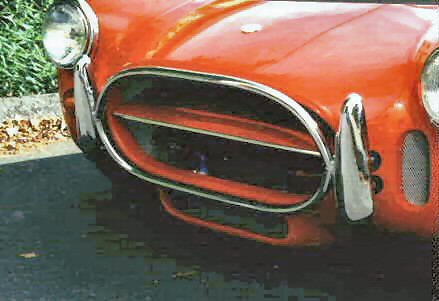 | Why
do you offer a reverse-rotation Smiths speedometer?
It's impossible to know the exact distribution of the
speedometers, but Computerworks offers his research on Club Cobra.
Did
some digging on
this one a while
back...
It seems a few of the first Comp cars had standard
rotation... the remainder of the Comps and S/Cs had reverse rotation.
It looks like the first production run of street 427s
(CSX31xx)
had standard speedos....and that CSX32xx and up had reverse ones.
This may not be 100% accurate, but it's close, based on early
photos
and current cars that appear to have original instrumentation. |
CONSTRUCTING
THE KIT What
do I have to fabricate? Every basic bit
that you
can't buy
off-the-shelf is
included in the kit. You don't have to make or engineer anything.
Do
you include the nuts and bolts?
Almost
every fastener is included in the kit, unless it is specific to
installing your particular drivetrain. We use stainless steel
screws
in non-critical but corrosion-prone places like for the hood
and trunk
hinges. Pems (or other systems captive threaded nuts) are
used
extensively so that no place requires two people to
install a
component.
The
suspension pieces are all Grade
5
or Grade 8
where appropriate.
What
is the most difficult part of building the kit?
Probably
building the rear suspension assembly.
It entails lots of
shimmed bearing packs, seals and caliper/emergency brake rebuilding.
Even with the experience of doing hundreds of assemblies, we still
spend about 15 hours on each one. If you still
want to do
it, we
can help a bit with parts and advice, but you should still get a good
manual. Alternately,
you can purchase an assembly from us or Concours West, a Jaguar
rear-end specialist. Birth of a
New Machine - Dan Somers' story of building an ERA.
Do
you have a "turnkey minus" package?
We don't
have standard "packages", but because
we
are so flexible, we can build exactly what you want in a kit.
If
you "back out" of the turnkey specifications by subtracting roughly
$9000 for the standard engine and transmission, you can get a good idea
of the costs involved. We also have some sample
kits listed here. We can also
supply every single
part so that you won't have to search for a single thing. Here's a list
that we prepared in
August 2005 for a customer.
Speaking
of manuals, what's yours like?
| Originally Posted
by Jon
Miller
The
best
single purchase I made during the construction of my Everett-Morrison
was the manual from ERA.... 
Thanks,
Jon |
Yep, me too - when I built my Unique.
__________________
Phil |
About 150
pages of detail, including exactly what you
need, how to
prepare the used stuff, and how to assemble it all on the kit.
Lots of illustrations. Most of the pictures are
line
drawings, not hard-to-interpret photographs. We used some of
them
here in the web
illustrations. About 20 sample pages are posted here.
The text part of the complete manual is also posted on the web
in PDF format
if you want to see the list of required parts.
The
complete
manual is also available in hardcopy or PDF
format here.
| The
wiring
instructions come separately - another 20 pages, so you don't have to
drag the whole book around when wiring the car. |
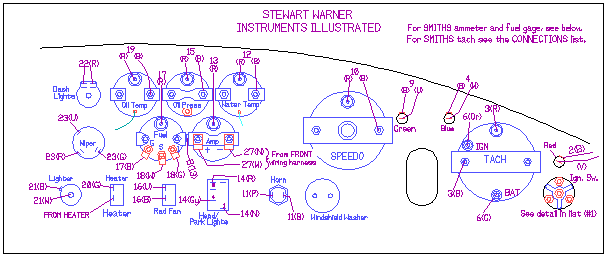 | | I've
never done any wiring! I know nothing about electricity!
You
don't have to be an expert to wire the car. Our wiring
instructions have lots of pictures and every connection is explained.
Wires are both color
codedlabeled,
and every wire is exactly the right length, resulting in an ultra-neat
final product. The picture at the right shows the stock
firewall
connections (just as the harness comes out of the box). The
fuse
blocks are even pre-wired (because we build the harness on a board by
connecting right to the fuse blocks).
and |  |
| What
if I don't want to do
some of the kit building stuff? We
will do anything you want to help you complete your kit. Each one is
custom made to your specifications. Do
I
have to buy
the trim and hardware? All
hardware, with the exception of the blind rivets, comes with the kit.
This includes the nuts, bolts, grommets, clamps and screws. And most of
it is already installed on the kit. Some of the exterior
badges are optional, to keep us legal.
What
if I can't find a part?
Since E.R.A.finishes
assembling some
customers' cars
in house, we stock just about everything you will need to finish your
kit. Some people have us supply every single part to complete the car.
Do
you sell parts to the retail aftermarket? Not
currently. We only service ERA
cars and customers' needs.
You can try the following companies: Ken's Specialty Auto
(315-793-0639
Finish
Line (888-436-9113 or 954-436-9101 -
FL and Int'l)
Cobra
Restorers (770-427-0070)
Brooklands
(305-776-2748)
Nisonger
(914-381-1952)
Shell
Valley
(800-356-9198)
Operations
Plus
Does
your body need painting? Yes.
Some
companies sell their car in "finished" gel-coat,
claiming they don't require
paint. But gel-coat will never look as good as a clear-coated
paint job, and you have fewer color and finish choices.
Repairing
gel-coat is much more difficult, also.
| 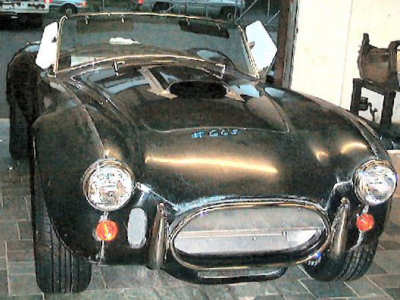 | |
How
difficult is it to paint
the car? Preparation for paint
is
straight-forward
and doesn't require any
specialized fiberglass work. The seams where the mold pieces meet must
be filled with standard body filler, but the basic body shape doesn't
require anything more that a skim-coat of polyester or epoxy filler to
facilitate blocking. E.R.A. doesn't do painting in-house, but
we
do have two very reliable sub-contractors: Connecticut
Custom Car - ($10k and up) and Big B's Autobody in
West Hatfield, MA (413-247-6360). If you visit
our shop,
you'll see many examples their work.) You will deal
directly
with
them for payments and other details. We don't make any money on this
sublet. |
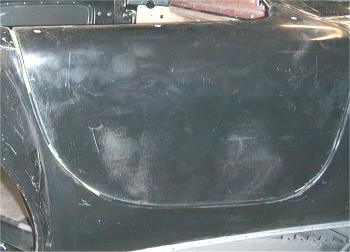 All the body panels are
pre-assembled at the ERA factory to insure good fit. Door
gaps
are uniform and don't require significant bodywork for a great-looking
fit. | Original
Colors According
to Computerworks,
posting on ClubCobra,
these
colors
were offered as standard colors on the 427 street cars: Guardsman
Blue A-1630
Charcoal
(Lincoln Charcoal
Frost) A-1786
Ivy Green
(Custom) A-1738
Raven Black
A-946
Maroon
(Custom)
Silver
(1965 Lincoln Silver
Mink) A-1784
White -
A-1347
Rangoon Red
A-1440-R
Wimbledon
White A-1633
However,
the 427
Comp and S/C cars came over bare (unpainted) and were painted to order
at the Shelby facility. Besides the stock colors, the list below
contains all the original (as shipped) colors for the Comp & S/C
Orange
Ferrari
Yellow
Candy Apple
Red
Ivy Green
Sapphire
Blue
Green
Silver
Green
Metallic
Hertz Gold
Guardsman
Blue
Rangoon Red
Navy Blue
White
Silver
Maroon
Silver Blue
Metallic |
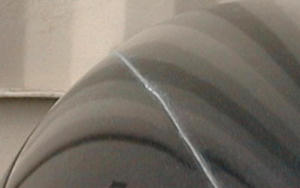 The seams along
the tops of the fenders are
small, and the panels on either side of the border are at the same
height. We have purposely made the seam area a bit low, so
that a
small amount filler is added. That way, you don't have to
grind
into the fiberglass, exposing the raw fibers. | 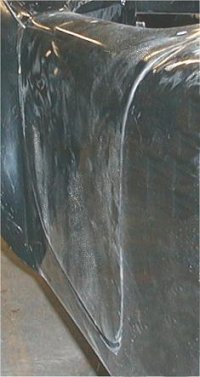 Sighting down the side of
the car, you can see that the panels match very well.
The
doors are hinged, latched and aligned when you get the basic kit.
| Can
I install the mechanical bits in a bare chassis without the body
installed? Yes, but we don't
recommend it. With our turn-keys, we usually mount the body on the
chassis first, then have the car painted. Finally, we install the
drive-train. The engine, transmission and suspension install easily
with the body already in place.
What
paperwork is included with the kit? Each
kit comes
with a Certificate
of Origin
(also known as a MSO). This carries the date of delivery, not
1965. SHIPPING
 How
is the car
shipped?
How
much will shipping cost? How
is the car
shipped?
How
much will shipping cost?
If
you
are within 500 miles and have a tow vehicle, consider picking the kit
up yourself with a flatbed
trailer or rental
truck. We don't charge any extra for loading
your car into
your own trailer or onto any shipper that you've chosen. Just
bring your own tie-downs.
For major distances, we typically use Intercity
Lines, Horseless
Carriage, Sunday
Transport or Roadshow. They
ship inside a box trailer all over the country. The price depends on
your location. To major cities on the west coast, the cost would be
about $3000. Trips to Florida run about $1600. If you are off the major
routes, it may cost a bit more. Other shippers may cost less, but your
car might sit in a depot for a bit, waiting for a direct ride. Most
shipping companies have a $500 minimum charge. For short runs, we may
be able to arrange transportation on a flatbed truck for about
$1.50/mile. For
overseas
shipping,
there are
several companies that specialize in transporting cars. SeaExpo
is one that we've
seen recommended on the public forums, but we have no personal
experience with. Shipping in a container is highly
recommended
for security.
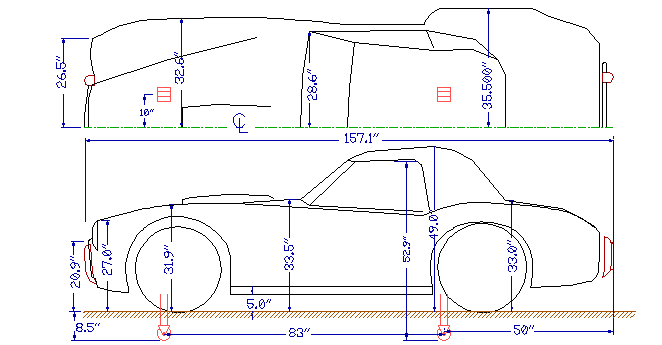
I'm from
outside the U.S.
Can I get one of your cars? ERA
does not
use dealers in the USA or Europe,
so all your dealings
will be directly with us. The difficulty varies from country
to
country. Sometimes there's a stiff tarriff.
| Many
countries have
strict
"performance" and design standards for complete or composite cars.
ERA has not
done any
testing for compliance for any country, and you should assume that we
will NOT
meet their
new-car standards or their special
requirements for
composite vehicles (kits).
It
has been suggested that, since some U.S. states title their kits as
1966 vehicles, it might be possible to import a used ERA from such a
state into their country. You do so at your own risk!
Such
an action goes contrary to the spirit of the law (and you might be
subject to post-import penalties).
| Most countries (most notably
Canada)
will accept "parts" from outside. We have, on occasion, split
up
a kit into separate shipments to make it easier for
importing. More
Information
WHEN
THE CAR IS DONE...
How
do I inspect and register my car in the USA?
There's no such thing as "50-State-Legal system.
Registration
requirements varies from state to state. Most states will
define
your kit as a Composite or Home-built, some will call it the year that
it's registered, some call it the year of car that it represents:
1965-1967. Because the cars have a special registration
designation, no state requires you to meet current safety regulations
although many will have a safety inspection to check on the basic
construction. Contact your state Motor Vehicle Department for
details and, if you have to go through an inspection, show up
completely compliant! The link below will direct you to
individual states' sites. California cars, if
they don't
have a pre-1964 engine, must be registered under the SB100 system.
Connecticut, one of the more difficult, requires that
the car be
trailered to a central inspection station. There, they check the
lights, brakes and general construction of the vehicle, and also make
sure that none of your components are stolen. Keep
your receipts! People have
posted what they describe as the
easiest states. For
more details on inspection
and registration, click here!
Do
I get a
title from ERA? No.
We give you a Manufacturer's
Certificate of Origin
(also known as an MSO) for the kit, plus a Bill
of Sale.
When you register the car, the state will issue you a title
and
registration number
based
on
those documents (and the invoices from your major parts)..
Most
states will also collect appropriate taxes at that time too.
What
about emissions?
Emissions standards for
composite vehicles
also vary
from state to state, and even regions within states. Most states will
require that your car meet the specifications for the year of your
engine. Another reason to stick with an early engine. Side
pipes
with catalytic converters
are available but we've never had to use them. It is usually
possible to title the car as a pre-emissions vehicle as described in
our REGISTRATION faq
above.
What
about insurance? It's
surprisingly easy.
In some
cases a
"Composite vehicle" can be insured by adding it to your current
insurance. There are also some companies that specialize in
this
kind of car, like Lundberg
Insurance
(an ERA owner!),
Heacock
or Midwest
Classic.
The cost is pretty reasonable, with only some mileage
restrictions. More popular companies are listed here.
How
difficult is it to maintain the car? Remember
how easy it was to work on cars made
in the '60s?
Welcome to the past! In spite of the size of the
engine,
there's plenty of room to do normal maintenance like spark-plug or oil
changes. And if you want to get "modern", you can add
electronic
ignition too. The front suspension uses very
common GM
replacement
parts and service techniques. The rear suspension uses common
Jaguar parts. All roller bearings and seals sare standard sizes,
available at automotive and bearing supply houses. Part
numbers
for all replaceable parts are listed in the Assembly/Service Manual.
There are
many suppliers specializing in Ford engines and various
transmissions. What
happens if I damage the car? E.R.A. will
sell you
any repair part you need
to fix it: Fender,
hood, or even a complete body if necessary. We also can make
pieces of the chassis and the proper dimensions for repair.
When
my car gets "old" can I update
to your latest and greatest stuff?  |
As much
as
practical! We don't make that many changes, but any
improvements
that we make are available to customers as update packages. A
history of significant changes is listed here.
At
the left is chassis 051 (built in 1983) having
some
mechanical updates installed. |
| Can I race my car?
Many of our
customers spend time on the track at
club events, and there are
now several regional series for Cobra replicas. Check out the Vintage
Sports Car Drivers Association.
They run some
events open to replicas. In the Northeast, the COM
Sports Car Club allows replicas to
compete in full track
events too. |
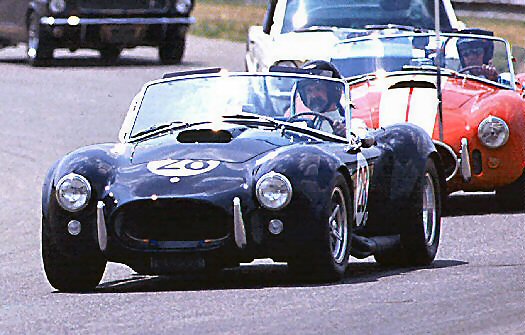 | | Joe Rodamista's
427 in an open track event.
He has since switched to an ERA 289 FIA, competing in many
events, including the 2000
and2001
Northeast
Replica Challenge. |
| | The Performance
Drivers
Assocication and Sports Car
Driver's Association also run events for their
members. SCCA has now certified replicas to run
in the Solo
II prepared class
rather than the modified (completely open) class. We can now
compete against the real thing legitimately! We
offer
extra-large front and rear brakes and an optional
rear suspension for track use.
Our optional coil-over dampers are externally adjustable for
height and stiffness, making at-the-track changes very easy.
Click
here
to link to some video done at Pocono by the Performance Driver's
Association.
Look for a light blue ERA FIA on the "in store for
you" video. We've done
quite well in
the
Northeast Replica Challenge too! We've posted the results for
2000
and 2001
|
WARRANTEE
How
do you
support your products? We don't
have a written
warrantee, but we will replace
anything defective within a reasonable period. After all, the
amount of time that people take to complete their kits varies
immensely. We have replaced pieces 5 years old. If you insist on something
written, you can write your
own! We will agree to anything reasonable.
REFERENCES
Can
I get names of people who
have built your kits? Of
course.
We can frequently find someone right in your area so that you
can
look at the "real thing" locally. Most owners are willing to
talk
at length about their experience. Some don't like to be
bothered,
though, so you must get
namesfrom
our General Manager and customer liaison, Pete
Portante (860-224-0253) at E.R.A.
Sorry, you cannot
get
references through
e-mail. You can also get independent
information at the
independent site E.R.A.
Owners Registry
PAYMENTS
AND DELIVERY
Why
is your kit more expensive than most of the others?
The E.R.A. 427 and 289/FIA kits come only in
what others
call a "Deluxe Stage". We don't offer a cheapo version of our cars.
Frankly, we value our reputation too much to allow some people to
butcher the concept and then claim that theirs is "an E.R.A." . We have
included so much in our kit that, when completed, they all have the
same high quality of design and materials. This fact is evident in the
strong demand (and high prices) for our used cars. This car may
actually turn out to be one of the most economical cars you've
ever driven!
Just
how much is
this going to cost? Check out some sample
kits!
How
can I get an official quote?
Please call Peter
at 860-224-0253.
Sorry, but
you can't get a quote over the
internet.
How
about backorders?
E.R.A. seldom delivers a kit
with anything
serious missing. Backorders
are always shipped so that your construction process won't be
disrupted.
How
do I
get the process started? We
require a $5000 deposit
to get you
in line for a kit or complete car. Once we get your
deposit, the kit price is
locked in -
even if you defer delivery for 6 months.
What
about the
rest of the payments? You
must
send another $5000 when we actually begin production of your kit. If we
are finishing your kit, timely payments to the engine builder and
painter will keep everything on schedule. Some extra payments for
special parts may be required during custom construction.
Other
taxes - sales and registration
taxes - are typically paid when you register your car. For
Connecticut residents, we collect the sales tax when you pick up your
kit. You will not be double taxed. When the kit
or turn-key
is delivered (or picked up), the balance must be paid in cash or with a certified check
unless
previously arranged. What
if I want to cancel the kit
after I've given you a deposit? The
deposit is 100%
refundable up until the
time we actually start
building your kit.
Can
the details
of my order be changed
after the deposit? Anything
can be changed up until the time we actually start your kit.
After that, we're still flexible, but there are limitations! 
Is financing
available? E.R.A. doesn't
finance, but for a
turn-key car
there are companies that
specialize. Look at the CobraCountry
web
site for possibilities, or in the back of Kit Car or Kit Car
Illustrated. Companies that have solicited us (but we cannot
vouch for) are Gettysburg
Financial, 954-786-2642, CreditCorp
USA , (954) 771-2440, or JJ
Best. Kits are more difficult to fund.
You will
have to use some other personal or business asset as collateral for a
bank or personal loan.
How
long will it take for me to get a kit? Actual
production time for a basic kit is about
2-3 weeks, but there is
usually a waiting list, typically varying from 3 to 8 months.
Occasionally, we might have an available spot in the queue from a
cancellation, but this is unusual. Is
there any way I can get "immediate"
delivery? Bakker
Ventures sometimes stocks
kits that are available now.
What
if I want my car even later than your waiting time?
Your deposit will hold your car for up to 1
year at the
original kit price estimate. What
is the time frame for a turn-key car? Add
about 8-12
weeks over the kit
schedule for painting, wiring and mechanical parts installation.
Are
there any unfinished kits available? Rarely. Although some
people sit on their kits
for some time because of personal reasons, almost all are completed by
the first owner. As an act of desperation, check the ads in
Kit
Car and Kit Car Illustrated, or in CobraCountry.com,
CobraForum.com
or ClubCobra.com.
What
about used cars? We
generally
don't deal in used cars unless it's a rare trade-in. Hemmings,
CobraCountry.com,
Club
Cobra, the For
Sale section of the ERA Registry site, and Dayan's
House of Cobras frequently
have ERA's, though, but don't expect any bargains. Resale
value
on ERA's is usually very high. The good part of that
equation is that if you ever want to sell your car, you can get top
money - without waiting forever. What
changes
have been made since the beginning? Small
changes in production methods have been
made continuously, but
most of those don't effect the performance or quality.
Fortunately, the basic design worked very well from the beginning, as
witnessed by the high value of used cars. The chassis number can be
found here.
The
most significant changes are as follows:
| Begins
at chassis # |
CHANGE
| | 6
| Wiring harness design finalized |
| 50
| Aluminum
floors replace steel | | 70
| Subaru steering gear
replaces Nissan | | 92
| ERA
tubular subframe replaces XKE sheet-metal
one | |
150
| Footboxes lengthened
for extra leg room | | 220
| Tilton master cylinders
replace
ATE brand *
| | 265
|
Bulkhead behind seats moved, exposing the
roll bar lower legs | | 350
| Front X member between
front suspension
towers changed from square
to round tubing | | 565
| All chassis have
mounting points for ERA
rear suspension | | 600
| Aluminum radiator
instead of brass, using original
style top and bottom
mounts and
shrouding | | 650
| Wiring harness improvements for easier
installation | |
731 |
Major improvements
to body, inner panels and
chassis | |
758 | Steering
gear and mounting system
changed | |
*
Recommended update |
How
many 427's have
you made? We have shipped over 800
427 kits to date.
How
big is E.R.A.? We employ
more than
10 full time people working in 4 buildings at our central location plus
a separate R&D and ERA GT facility down the street.
We do
almost everything in house: chassis, body, small parts, rebuilding of
rear suspension, upholstery, wiring harnesses and turnkey cars. We
sublet the casting and machining, and most of our sheet metal is done
on a CNC laser or punch machine (by a vendor whose owner
just happens to own both a 427 and a GT - you know he's
obsessive
about quality!  ). ).
What
other things do you do? Most
of
our energy is devoted to the kits, but we do supply some small
reproduction parts to the rest of the kit car industry.
How
we do things at E.R.A.
| Where
are the chassis made? All
chassis tubing
components are cut
right at the factory. Most
of the sheet metal components are sublet to a CNC punch shop where
tolerances are less than +/- .010". All separate
components
are MIG or TIG welded right in our own jigs at the factory.
When
you visit us, look at the high quality of the welds. Our
certified welders are good! |
 | And
the suspension? Suspension
components are done
the same way.
Arms are cut and jig
welded right here. The GT arms are TIG welded. The
427/FIA
arms are both MIG and TIG welded, depending upon application. Castings
are done locally from AlMag or 356 heat treated aluminum.
Some of
the pieces are machined from billet.
| How
is
the
interior done? Everything but
the
427/FIA top and car covers is produced in
house. |
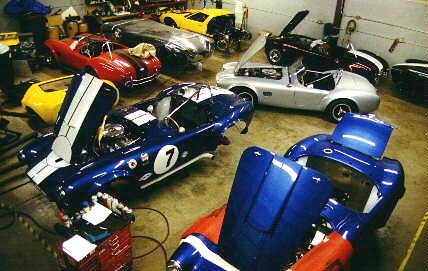 |
Do
you do the fiberglass molding?
All
our 427 and FIA moldings are done
in-house.
We
built all the molds
from our own plugs.
All pieces, including the hood and trunk lid, and
inner
panels are hand laid at E.R.A. Mating of the inner panels
to the
outside skin is also done in-house. We don't use ordinary
polyester resin, either. We spend a little extra money to get
low-shrink
tooling resin for better long-term dimensional stability.
Dealer
information E.R.A. has a very
limited network
of
dealers. We may offer a small
discount for multiple purchases within a limited time frame. Since our
profit margin is small, this discount is not deep. Call Peter
for
details. 860-224-0253, 9am-12am, 2:30pm-5pm.
Since our
car
is so easy to build and has a very high resale value, many people have
built multiple cars. Most have made reasonable money, but don't expect to get rich.
Our
fee for prepping and installing the engine, transmission, suspension,
electrical system and interior is typically $6000-$7000.
| 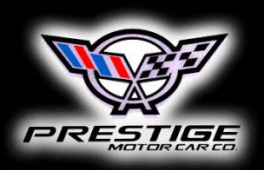
| How
difficult is it to put your kit together?
Assembling the chassis and painting the body is
straight-forward.
Have us powder-coat the chassis and bond the body.
It will
save you a lot of time, and it isn't very expensive.
Rebuilding
the rear
suspension is
fairly complicated. If you don't have Jaguar experience,
expect
the first one to be "a learning experience". Once you get
everything figured out, expect to spend about 12-15 hours on a rebuild,
plus parts. If it isn't a limited slip, add about $600.
The
most difficult part of building a turnkey is the engine.
Many turnkey buyers insist
on a 427 Side-oiler rather than the 428. 427 cores are very
rare
and are hoarded by many engine builders. If you don't have a
cache of cores, don't count on getting one at a reasonable price.
428 cores are easier to come by and really make a better
street
engine. 289/302/351 engines are relatively cheap and easy to
build, but most people who want a 427 also want the correct engine.
The 289/FIA
is a great home
for a small block. We recommend that you build a
single car
to acquaint you with the building process before you commit to multiple
cars If you do decide to jump in with a multiple order, your deposit on
each kit is fully refundable up until the time we start it.
You
can't lose money on a deposit. Can
I visit the factory? You bet! Click
here for
directions to
get to the
Factory
How
can I contact ERA? Peter (our General
Manager) can
be reached on
weekdays by phone,
9am-12am, 2:30pm-5pm, 860-224-0253 You can fax questions to
him at
860-827-1055. You can e-mail us here.
Sorry, but we can't
quote cars
via e-mail. It's best to talk to Peter about your
requirements.
Some sample kits are listed here.
About
E.R.A. How
long has E.R.A. been in business?
E.R.A. began in 1968, doing restorations of
Porsches, BMW's and several British cars. In the first year, we fixed a
totalled 289 Cobra (bought for only $1500 at the time by our
current general manager, Pete Portante. The car was sold
about 8
years later - before the prices went crazy, of course. ) and a
Fiberfab kit car, among other projects. In 1981, we started
on
our 427 replica. By 1985,
all our restoration work ceased - we were
just too busy doing our 427. So far, we've delivered over 800
kits to 30+ states and a half-dozen countries. ) and a
Fiberfab kit car, among other projects. In 1981, we started
on
our 427 replica. By 1985,
all our restoration work ceased - we were
just too busy doing our 427. So far, we've delivered over 800
kits to 30+ states and a half-dozen countries. In
1990 we
delivered our first ERA
GT. In 1997 we delivered our first 289FIA.
In 2009 we produced our prototype Slabside,
with
delivery of the first production kit delivered in 2010 .
We currently
have around 14 full and part-time employees.
Our workers are approximately evenly distributed among the
fiberglass, welding and fabrication, kit assembly, final assembly,
R&D, wiring, and office staff, with many wearing several hats
each
day. We sublet some sheet-metal parts, but the
final product is always processed right here.
A
SHORT HISTORY
OF E.R.A. Era
Replica Automobiles
is a historical extension of International
Automobile
Enterprises, Inc. I.A.E. was founded in 1966
with a vision:
To develop the necessary skills, expertise and equipment to ultimately
produce world class performance automobiles.
Over 30
years ago, the E.R.A. design concept
was put on paper: To create new versions of the cars that we all
dreamed about but couldn't afford. We wanted to provide
enthusiasts like us with cars as close to the originals as possible.
Not only the appearance would have to be authentic, but the feel, sound
and mechanical layout would also have to be like the originals'.
We wanted to bring you to back to another era, to give you
that
same exhilaration you would have gotten then, now. A driving deja vu,
if you will. Like many (poor) car enthusiasts,
we started at
the
bottom, doing mechanical repair, welding and body restoration on our
own cars. Within a short time, we graduated to servicing customers'
Porsches, BMWs and other specialty cars. In 1968 we built our
first kit car (Fiberfab - what a nightmare!) on a VW chassis. This
project involved extensive body restyling and chassis modifications. To
do the body modifications properly, we built our own molds to make the
new panels. Our skills became well known
locally, and we
were hired to duplicate or modify lightweight fiberglass bodies by
several prominent formula and sports car racers. We also branched into
the manufacturing of spoilers, flares, and other replacement items for
Porsches, BMW's and Datsun Z's. In addition, we developed, built and
raced a 1953(!) Austin
Heally in F Production, winning the New England Championship a couple
of years. Meanwhile, our Porsche restorations
led us into
the restoration parts business. Chassis and body panels were no longer
available from Porsche. We made our own tooling, and purchased a press
to manufacture these parts ourselves. At one time we supplied a major
portion of all the Porsche 356 sheet metal sold world wide.
Now,
alas, the US retailers have outsource the manufacting of the steel
panels to the far east. As our skills developed,
it became
plain that we
were now capable of
living out our original dream. Making Our Own Car!
The most
famous 60s sports car was at the top of the list of the cars
we
wished to make, so when the first roadster replica appeared, we
purchased
one. The kit was incomplete and very difficult to put together . It was
easy to imagine a person without professional fabrication skills and
equipment finding himself with a permanent, unfinished project in his
garage. We knew we could do better. We carried
out extensive
research and development, insuring that every replica from E.R.A. would
be the most exacting and best engineered available anywhere, and that
its performance would equal or exceed the original car's, right out of
the box. Since we started manufacturing kits in
1981,
we've
consistantly built between 35 and 50 kits each year, in spite of the
ups and downs of the economy. Having a reputation for quality
in
construction and service doesn't hurt.  |
|








 The
original Shelby Cobra wheels used a
single wing nut that secured each cast magnesium wheel. The power was
transferred from
the hub to the wheel by six pins. The 289/FIAs used a casting unique to
the race cars.
The
original Shelby Cobra wheels used a
single wing nut that secured each cast magnesium wheel. The power was
transferred from
the hub to the wheel by six pins. The 289/FIAs used a casting unique to
the race cars. 









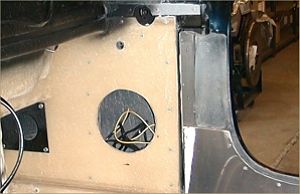
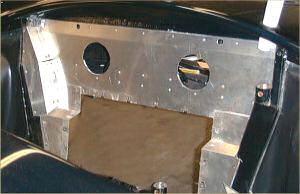








 How
is the car
shipped?
How
much will shipping cost?
How
is the car
shipped?
How
much will shipping cost? 





